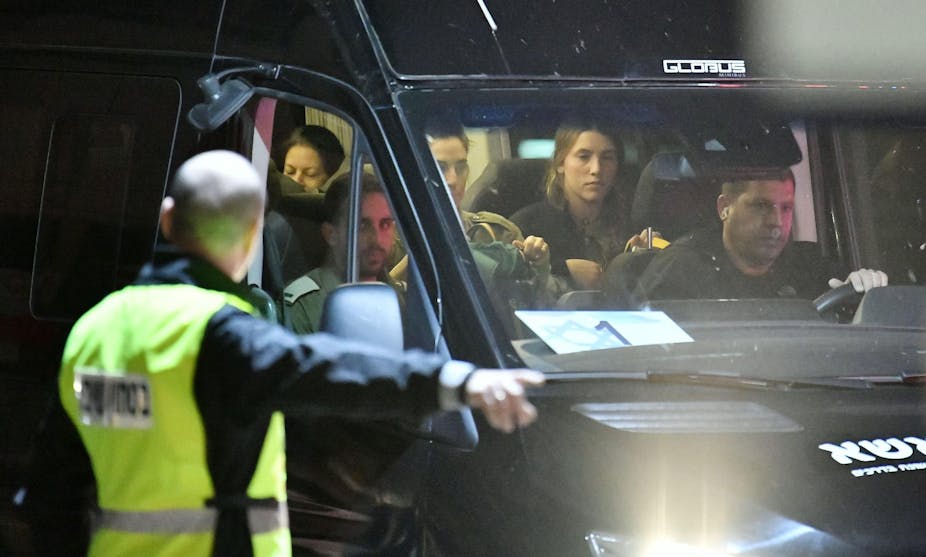During the seven-day truce agreed between Israel and Hamas, seven exchanges were made of hostages held by Hamas for Palestinian prisoners held by Israel. But on November 30, the two sides failed to reach an agreement on the eighth exchange and there has since been a resumption of the fighting in the Gaza Strip.
While this “humanitarian pause” continued, 107 hostages – including 83 Israelis and 24 foreign nationals – who were taken by force by Hamas on October 7, were returned to Israel. The majority of them were young children and their mothers. A few elderly women were also released.
This leaves 135 Israelis still being held in Gaza. Only three of these hostages were members of the Israel Defense Forces on active duty at the time of their capture.
The Geneva conventions explicitly prohibit the taking of hostages and the prohibition is “now firmly entrenched in customary international law and is considered a war crime”. This applies to civilians, veterans, and combatants.
While combatants may fall under enemy control and be considered prisoners of war, it is unlawful to capture combatants in order to compel a third party to carry out or abstain from something.
The taking of Israeli hostages is not a new strategy for Palestinian militant organisations, who have used hostages as bargaining chips for prisoner swaps. But the scale and demographics of those captured on October 7 are unprecedented.
Former hostage negotiator Gershon Baskin told the Christian Science Monitor that the senior Hamas leader considered to be the architect of the October 7 attacks, Yahya Sinwar, is personally dedicated to ensuring the release of all Palestinian prisoners held in Israeli jails, having promised to do so following his release as part of a 2011 prisoner swap.

Evidence from a Hamas planning document revealed by the New York Times showed there were specific instructions to Hamas fighters to capture hostages precisely for this goal.
Thus far, Sinwar’s strategy has worked. Due to pressure domestically – not least from hostages’ families – and from Washington, Israel’s prime minister, Benjamin Netanyahu, agreed to a three-to-one ratio release of Palestinians for Israelis, alongside a temporary ceasefire.
During the exchange, 240 Palestinian women and children have been released, the majority of whom are children 18 or under. Some were charged with terrorist activity, others included stone-throwing, throwing firebombs and possession of weapons.
The more prominent Palestinians freed include activist Ahed Tamimi, 22, who was first arrested for slapping and kicking an Israeli soldier in 2017 after her 15-year-old cousin was shot in the head with a rubber bullet. She had been active in the popular resistance in her village of Nabi Saleh in the West Bank. She was rearrested in November for allegedly inciting terrorism online.
Two others, Misoun Mussa and Marah Bakeer, were sentenced in 2015 to 15 years and eight and a half years, respectively, for stabbing attacks. None of those released have murdered Israelis.
It has been reported that nearly 80% of the 300 Palestinian women and children detainees who were initially identified for release have never been formally charged. This has shone a harsh light on Israel’s military judicial system, particularly this policy of administrative detention.
Administrative detention
Administrative detention is where a person is held without trial and without having committed a crime on the presumption that they intend to break the law in the future.
International human rights law allows for some limited use of administrative detention for imperative reasons of security. It is also permitted under article 285 of Israeli military order 1651 regarding security provisions in the West Bank.

But my research highlights that, despite Israeli laws containing provisions to protect detainees and limit the use of administrative detention to only extreme circumstances, it has been used extensively. According to the human rights organisation Addameer, there were 2,409 administrative detention orders issued in 2022.
Higher value prisoners
The hostage deal so far has involved women and children, most of whom were held under administrative detention. So it is relatively easy for the Netanyahu government to justify their release in these circumstances.
But from here, negotiations for further exchanges are likely to become more difficult. The Israeli security establishment will be reluctant to release Palestinians who have been convicted of murder and who are considered to pose a significant security threat. Hamas, meanwhile, will place a higher value on the men that they continue to hold.
In 2011, Israel released 1,027 Palestinian prisoners, including 300 who had killed Israelis, in exchange for one Israeli soldier, Gilad Shalit, who had been held captive for five years. Gershon Baskin, who led the back-channel negotiations, details the complexity of reaching this deal in his 2013 book, The Negotiator: Freeing Gilad Shalit from Hamas.
Given the remaining Israeli hostages in Gaza are mostly fighting-age males, the price for their return is likely to be much higher than has been agreed upon thus far. Sinwar is said to believe that he has enough Israeli hostages to enable the release of all Palestinians held in Israeli jails, which now number 7,200.
Now that the fighting has resumed, the humanitarian crisis in Gaza is likely to worsen as Israel pushes further and further south. It’s hard to see how or when it will be possible for the antagonists to reach further deals.

